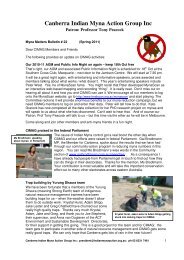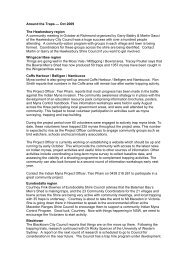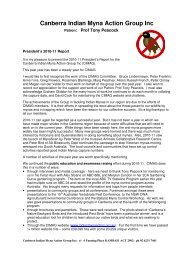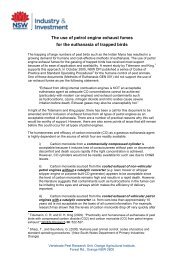Bega Valley action - Canberra Indian Myna Action Group Inc.
Bega Valley action - Canberra Indian Myna Action Group Inc.
Bega Valley action - Canberra Indian Myna Action Group Inc.
You also want an ePaper? Increase the reach of your titles
YUMPU automatically turns print PDFs into web optimized ePapers that Google loves.
1<br />
Making the Common <strong>Myna</strong> a Rare Species in the <strong>Bega</strong> <strong>Valley</strong><br />
Jim Shields, the <strong>Bega</strong> <strong>Valley</strong> Common <strong>Myna</strong> Task Force<br />
The <strong>Indian</strong> (Common) <strong>Myna</strong> is increasing its range into smaller centres and semi-rural areas,<br />
and the <strong>Bega</strong> <strong>Valley</strong> has not been exempt. However, the <strong>Bega</strong> <strong>Valley</strong> district still remains<br />
relatively free of this pest, due in part to the extensive areas of native forest around it.<br />
Nonetheless, there are sufficient mynas around to concern conservationists and land<br />
managers. Since 1996, the Far South Coast Bird Watchers have conducted a program to<br />
remove mynas wherever they are reported. Using local knowledge, public input resulting<br />
from flyers and newsletters, and the human resources and funding of the community over<br />
300 birds have been removed. Small pockets of mynas are known at a few sites. Recently,<br />
due to the increasing number of myna invasions, the COMY Task Force was set up to coordinate<br />
myna control activities.<br />
The COMY Task Force myna poster<br />
<strong>Bega</strong> <strong>Valley</strong> dairies are a ready<br />
source of feed for mynas and this<br />
provides opportunities for targeted<br />
trapping: it is the same where there<br />
are horse paddocks. The COMY<br />
Taskforce has had a program of<br />
trapping with a number of dairy<br />
farmers. Our experience has been<br />
that working with a rare pest species<br />
provides different challenges and<br />
solutions to those where it is superabundant.<br />
We have found that where the local<br />
landholder is provided with clear<br />
information about trap maintenance<br />
and myna behaviour, given Judas<br />
birds and continual feed-back,<br />
captures and local eliminations<br />
happen. What did not work was<br />
providing basic equipment,<br />
expecting that an interested but busy<br />
dairy farmer would find the time to<br />
figure things out on their own. Time<br />
spent in discussion and regular feedback<br />
is rewarded with more<br />
captures.<br />
Flexibility and adaptability are<br />
essential where mynas are rare. It is<br />
frequently possible to eradicate<br />
invading pairs by shooting - a tactic<br />
that is impossible or ineffective in<br />
metropolitan areas with thousands of<br />
birds. Most dairy owners are<br />
licensed shooters: there is no or<br />
little issue with human safety and low myna numbers mean that the task is not overly time<br />
consuming. The skills of the local Australian Deer Association members have also been a<br />
great asset.<br />
Judas birds and persistence work well.
At one particularly successful case at a dairy between Cobargo and Bermagui, the farmer<br />
has trapped over 80 birds. He set up the trap between the dairy and the residence, where it<br />
could be inspected regularly and became part of the local “habitat”. His Judas birds were<br />
well looked after, and he persisted with baiting, even after some big captures and an<br />
extended quiet period.<br />
Working with the operation of the farm (ie, finding areas that stock cannot access but which<br />
are still near the food source and regular human activity) is useful on a working dairy.<br />
Putting the trap where horses are regularly hand-fed gives both bait to lure the birds and an<br />
opportunity for the farmer to check the trap.<br />
One of our more elderly trappers<br />
laid trails of bait from the birds<br />
preferred perch site to the trap, and<br />
eventually eliminated the entire<br />
local colony.<br />
Conversely, an animal carer has<br />
successfully eliminated all the birds<br />
on his property by taking them into<br />
captivity, where they are a source<br />
of Judas birds, or, ultimately, food<br />
for his cats and the pet pig.<br />
Such variable tactics succeed in<br />
eliminating invading local populations.<br />
We have learned that communication and clarity are essential. Local animal welfare groups<br />
actively encourage our activities and we get great community input when they know our<br />
objectives. Lack of communication and clarity results in no success, confusion and in-<strong>action</strong>.<br />
2<br />
Trap making: COMY Task Force & Aust Deer Assoc<br />
The COMY Task Force<br />
realises that further census<br />
work and monitoring is<br />
required. Monitoring<br />
information at control sites<br />
needs to be collected now<br />
with regard to the distribution<br />
and abundance of woodland<br />
birds in the district, to provide<br />
management information on<br />
the effectiveness of the<br />
COMY control program. That<br />
is something we have on our<br />
future program.<br />
The control of mynas as they<br />
invade an area has provided<br />
unique management<br />
<strong>Bega</strong> <strong>Valley</strong> dairy farm trapping has been highly successful<br />
challenges – in the <strong>Bega</strong><br />
<strong>Valley</strong>, the myna is rare and,<br />
hopefully, through the continued success of our program, a threatened species.<br />
May 2009








